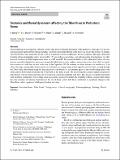Files in this item
Tectonics and fluvial dynamism affecting the Tiber River in prehistoric Rome
Item metadata
| dc.contributor.author | Marra, F. | |
| dc.contributor.author | Brock, A. L. | |
| dc.contributor.author | Florindo, F. | |
| dc.contributor.author | Macrì, P. | |
| dc.contributor.author | Motta, L. | |
| dc.contributor.author | Nicosia, C. | |
| dc.contributor.author | Terrenato, N. | |
| dc.date.accessioned | 2021-10-25T09:30:02Z | |
| dc.date.available | 2021-10-25T09:30:02Z | |
| dc.date.issued | 2022-02-01 | |
| dc.identifier | 276280096 | |
| dc.identifier | fd88dea0-6428-4114-bb25-c74ac17bc7f6 | |
| dc.identifier | 85116771077 | |
| dc.identifier | 000704961500001 | |
| dc.identifier.citation | Marra , F , Brock , A L , Florindo , F , Macrì , P , Motta , L , Nicosia , C & Terrenato , N 2022 , ' Tectonics and fluvial dynamism affecting the Tiber River in prehistoric Rome ' , International Journal of Earth Sciences , vol. 111 , pp. 359-378 . https://doi.org/10.1007/s00531-021-02118-5 | en |
| dc.identifier.issn | 1437-3262 | |
| dc.identifier.other | RIS: urn:98B190D0C4ECE45C6528299E0B2FAE9A | |
| dc.identifier.other | RIS: Marra2021 | |
| dc.identifier.other | ORCID: /0000-0001-5390-7499/work/101581686 | |
| dc.identifier.uri | https://hdl.handle.net/10023/24188 | |
| dc.description | Funding: Open access funding provided by Istituto Nazionale di Geofisica e Vulcanologia within the CRUI-CARE Agreement. Research funding was provided by Loeb Classical Library Foundation, Gerda Henkel Foundation, American Philosophical Society, Etruscan Foundation, Fondazione Lemmermann, University of Michigan, University of St Andrews, and the Leverhulme Trust. | en |
| dc.description.abstract | Geomorphological investigations in Rome’s river valley are revealing the dynamism of the prehistoric landscape. It is becoming increasingly apparent that paleogeographic conditions that defined Rome in the historical era are the product of changes since the Bronze Age, which may be the result of local fault activity in addition to fluvial dynamism. Through a dedicated borehole chronostratigraphic study, integrated by 14C and archaeological dates, and paleomagnetic investigations, we offer here new evidence for fault displacement since ca. 4500 years/BP. We present the failure of the sedimentary fabric of a clay horizon caused by liquefaction processes commonly linked with seismic shaking, interpreting an (ca. 4 m) offset to signify the existence of a fault line located at the foot of the Capitoline Hill. In addition, we show evidence for another (ca. 1 m) offset affecting a stratigraphic horizon in the river channel, occurring along another hypothesized fault line crossing through the Tiber Valley. Movement along this fault may have contributed to a documented phase of fast overflooding dated to the sixth century BCE which eventually led to the birth of the Tiber Island. The most plausible scenario implies progressive deformation, with an average tectonic rate of 2 mm/year, along these inferred fault lines. This process was likely punctuated with moderate earthquakes, but no large event necessarily occurred. Together, the available evidence suggests that during the early centuries of sedentary habitation at the site of Rome, active fault lines contributed to significant changes to the Tiber River valley, capable of challenging lowland activities. | |
| dc.format.extent | 20 | |
| dc.format.extent | 6091971 | |
| dc.language.iso | eng | |
| dc.relation.ispartof | International Journal of Earth Sciences | en |
| dc.subject | Pre-urban Rome | en |
| dc.subject | Tiber Island | en |
| dc.subject | Coring survey | en |
| dc.subject | Alluvial stratigraphy | en |
| dc.subject | Paleomorphology | en |
| dc.subject | Faulting | en |
| dc.subject | Fluvial dynamics | en |
| dc.subject | QE Geology | en |
| dc.subject | NDAS | en |
| dc.subject | MCC | en |
| dc.subject.lcc | QE | en |
| dc.title | Tectonics and fluvial dynamism affecting the Tiber River in prehistoric Rome | en |
| dc.type | Journal article | en |
| dc.contributor.institution | University of St Andrews. School of Classics | en |
| dc.identifier.doi | 10.1007/s00531-021-02118-5 | |
| dc.description.status | Peer reviewed | en |
This item appears in the following Collection(s)
Items in the St Andrews Research Repository are protected by copyright, with all rights reserved, unless otherwise indicated.

